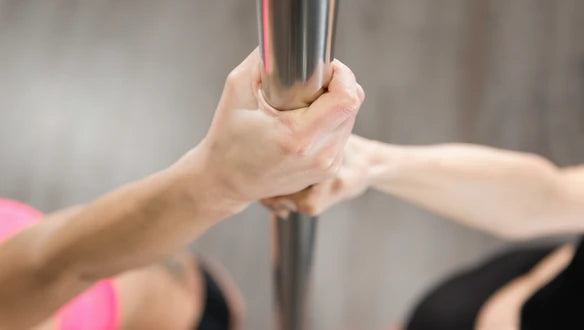I think I've lost count of the amount of students that I have taught who have asked me what they can do in order to get stronger at pole.
If these muscles are weak and an individual is trying to perform strenuous and challenging movements they can easily get injured due to the fact that they simply cannot support or lift their weight.
Core strength of course is important in order to stabilize ourselves, however I also would say the important factor here comes down to body awareness, this could be something like understanding where the legs are positioned when you're upside down. Let's face it if your legs are all over the place then how do you expect to keep your core strong when it is at full extension and your upper body is weak and unstable and can't support the hold?
In order to have a strong core you need to work the whole core. This doesn't just include "Ab workouts", movements that test your stability and require force in that position are vital and very important! No matter how many sit ups you do, you will never have a strong core.
The muscles within your core also known as the Trunk area (which is what I prefer to call it) include the:
- Erector spinae. The erector spinae is a back muscle that extends your trunk. It helps you stand up straight after bending over.
- Rectus abdominis. When you bend forward, you use an abdominal muscle called the rectus abdominis.
- Obliques. Your internal oblique and external oblique let you rotate or bend your trunk.
- Transverse abdominis. The transverse abdominis, which wraps around the front and side of your trunk, stabilizes your pelvis.
- Multifidus. The multifidus in your back supports your spine.
Now that we have understood the cores function and how it works, lets discuss the hips and its movement. Hip flexion is the lifting motion of our leg (bringing your leg towards your chest when your knee is either at extension or flexion. Read my blog on hip stability for more information on this topic).
Our hip flexors are linked with our core area as the muscle originates from our lower back and runs down the inside of our femur (thigh). The hip flexor role is to provide our body with core stability and it is the main muscle that enables us to walk. Flexing the hip.
An untrained core means that an individual will have tight hip flexors and usually severe hyperlorosis in their spine. Now if we were to take that individual and get them on the pole we can potentially be doing more damage than good due to the fact that in pole we are required to create beautiful BUT very hyperlordotic shapes with out bodies which is the last thing that that individual needs to be doing. In addition to this in pole our bodies are very rarely required to perform any violent hip extension (unless its for very dynamic moves, even then it is not required as much as other sports such as gymnastics and olympic lifting) and we never really perform any strenuous leg work which is important for our health, the prevention of muscle imbalances, muscle growth, posture and soo much more! This skill transfer is soo important as the gluteus Maximus and the hamstring group are the primary extensors of the hip joint. They help to open up our hip. If neglected and an individual is not working on strengthening these muscles required for hip extension, not only will it cause a lot of strain on their lower back but in addition when it comes to putting the individual onto the pole and getting them to create these flexible shapes they could actually increase their chances for getting injured as the body will not be ready to be in that position. (There are multiple exercises you can do in order to strengthen the muscles surrounding your hip. Head over to my hip stability blog to find out more)
In order to become a strong all round athlete there are multiple things that need to be worked on, however we all need a starting point, especially if you are new to pole. Take it step by step, below I have written a list of things that you should work on in an order that I have created. I would like to make it clear that this order written below is for someone who is new to pole and does not have a background in training or other sports. If you know that you need to work on a specific area then you should work on that area first. The end goal is to have a well balanced, strong yet flexible body.
Focus on one or two things at a time until you are happy with your progress then move on to the next step, If you try and focus on everything at once your progress will be slow and may leave you disheartened.
Step 1
1. Work on your PULL STRENGTH. For example start a pull up program.
2. Work on strengthening the muscles around your hips. Try improve your leg lifts, single leg stability and hip hinges. Maintain good core strength throughout.
Step 2
1. Increase the strength in your TRUNK AREA. Lots of isometric holds, hollow body positions, core rotation and unilateral work.
2. Ensure your upper body is well balanced. start getting your push strength a little stronger.
Step 3
1. Work on your hip mobility and start your split journey. Make sure you incorporate lots of active flexibility work.
Now that I have briefly explained what areas in our bodies need to be strong for pole, I hope it has helped you to understand what areas you might need to give some attention to.
"We as athletes do not fail because our skill level is low, but because we have not built our strength and stamina in order to perform those skills in a more demanding environment".
Mel,
Atria Team


